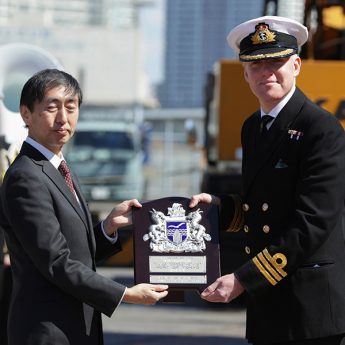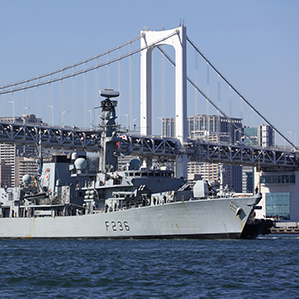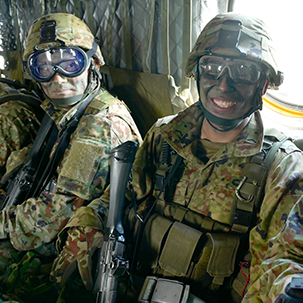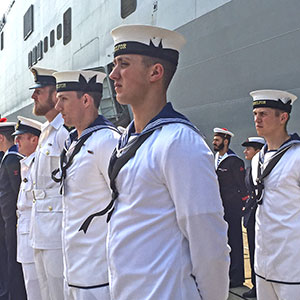HMS Daring, the lead ship of the Royal Navy’s Type-45 air-defence destroyers, pulled alongside Tokyo’s Harumi Pier on 30 November for a four-day port call.
The £1bn warship is on a 139-day tour that will see her visit 12 countries—including Australia and the US state of Hawaii—and travel well over 34,000 nautical miles.
“It is a real privilege to be here and my crew have been looking forward to coming here immensely. We are six months into a nine-month deployment and this is one of the highlights”, said Commander Angus Essenhigh.
Quoting Prime Minister Shinzo Abe’s description of Britain’s defence and security relationship with Japan as “a natural a priori partnership”, Admiral Sir George Zambellas said, “That comes from our shared political and economic beliefs, but also from our shared reliance on the sea.
“Next year marks the anniversary of the start of World War I, and we remember with thanks and affection the contribution that Japan made as Britain’s ally in the Great War”, Zambellas said.
“A number of your sailors died in the Mediterranean, just as ours did, so we have a shared history there. That should never be forgotten”.
“But what of the future?” the First Sea Lord asked. “We see this as a time of great opportunity as we both play our part in maintaining world order. My ambition is to forge even closer ties with Japan’s Maritime Self-Defense Forces”.
The 8,000-ton Daring was taking part in an annual exercise as part of the Five Power Defence Arrangements. These defence pacts involve the UK, Australia, Malaysia, New Zealand and Singapore, and are designed to protect Peninsular Malaysia and Singapore from external aggression.
The recent Exercise Bersama Lima 2013 was under way off the Malay Peninsula when Typhoon Haiyan struck the Philippines.
Ordered to break away and make best speed for the devastated region, the sailors and Royal Marines aboard were able to provide a measure of assistance to the hundreds of thousands of people affected by one of the most powerful and destructive storms in recent years.
In coordination with the government of the Philippines, Daring was able to put its helicopter to good use in search-and-rescue operations and the movement of humanitarian relief aid.
“The speed at which we have reorganised ourselves to prepare to help those in such desperate need in the Philippines demonstrates the flexibility of the Royal Navy and the high standards of my team on board,” said Cdr Essenhigh, ahead of the ship’s arrival in the disaster zone.
“We are fully prepared to assist with the aid effort, having been trained in disaster relief shortly before we deployed, and are ready to put those skills to good use”, he said. “We have a strong team, with no shortage of useful skills and equipment, who are busily preparing for what we may encounter”.
The British government was quick to pledge £10mn in aid and dispatched a Royal Air Force transport aircraft to assist in the relief effort, codenamed Operation Patwin.
The 200 personnel aboard Daring are well trained in such relief operations; the ship’s staff includes a doctor, dentist, engineers and first aid teams, as well as crews for aircraft and small boats.
The warship stocks 700 ration packs and 550 litres of bottled water, and can provide 20,000 litres of potable water within 24 hours. Generators, fire-fighting equipment and thermal imaging cameras are included among the items on board.
The destroyer’s crew has the capacity to set up eight feeding stations that can provide for 240 people at a time. In addition, Daring has an evacuation holding centre that can accommodate up to 700 people for 48 hours.





